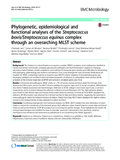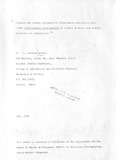Prevalence And Comparison Of Streptococcus Infantarius Subsp. Infantarius And Streptococcus Gallolyticus Subsp. Macedonicus In Raw And Fermented Dairy Products From East And West Africa
| dc.contributor.author | Kaindi, Dasel Wambua Mulwa | |
| dc.contributor.author | Böck, Désirée | |
| dc.contributor.author | Njage, Patrick Murigu Kamau | |
| dc.contributor.author | Kouamé-Sina, Sylvie Mireille | |
| dc.contributor.author | Bonfoh, Bassirou | |
| dc.contributor.author | Lacroix, Christophe | |
| dc.contributor.author | Meile, Leo | |
| dc.contributor.author | Jans, Christoph | |
| dc.date.accessioned | 2014-04-24T11:58:22Z | |
| dc.date.available | 2014-04-24T11:58:22Z | |
| dc.date.issued | 2013-10-15 | |
| dc.identifier.citation | International Journal of Food Microbiology Volume 167, Issue 2, 15 October 2013, Pages 186–195 | en_US |
| dc.identifier.uri | http://www.sciencedirect.com/science/article/pii/S0168160513004273 | |
| dc.identifier.uri | http://hdl.handle.net/11295/65961 | |
| dc.description.abstract | Streptococcus infantarius subsp. infantarius (Sii) and Streptococcus gallolyticus subsp. macedonicus are members of the Streptococcus bovis/Streptococcus equinus complex (SBSEC) associated with human infections. SBSEC-related endocarditis was furthermore associated with rural residency in Southern Europe. SBSEC members are increasingly isolated as predominant species from fermented dairy products in Europe, Asia and Africa. African variants of Sii displayed dairy adaptations to lactose metabolism paralleling those of Streptococcus thermophilus including genome decay. In this study, the aim was to assess the prevalence of Sii and possibly other SBSEC members in dairy products of East and West Africa in order to identify their habitat, estimate their importance in dairy fermentation processes and determine geographic areas affected by this potential health risk. Presumptive SBSEC members were isolated on semi-selective M17 and SM agar media. Subsequent genotypic identification of isolates was based on rep-PCR fingerprinting and SBSEC-specific16S rRNA gene PCR assay. Detailed identification was achieved through application of novel primers enhancing the binding stringency in partial groES/groEL gene amplification and subsequent DNA sequencing. The presence of S. thermophilus-like lacS and lacZ genes in the SBSEC isolates was determined to elucidate the prevalence of this dairy adaptation. Isolates (n = 754) were obtained from 72 raw and 95 fermented milk samples from Côte d'Ivoire and Kenya on semi-selective agar media. Colonies of Sii were not detected from raw milk despite high microbial titers of approximately 106 CFU/mL on M17 agar medium. However, after spontaneous milk fermentation Sii was genotypically identified in 94.1% of Kenyan samples and 60.8% of Kenyan isolates. Sii prevalence in Côte d'Ivoire displayed seasonal variations in samples from 32.3% (June) to 40.0% (Dec/Jan) and isolates from 20.5% (June) to 27.7% (Dec/Jan) present at titers of 106–108 CFU/mL. lacS and lacZ genes were detected in all Kenyan and 25.8% (June) to 65.4% (Dec/Jan) of Ivorian Sii isolates. Regional differences in prevalence of Sii and dairy adaptations were observed, but no clear effect of dairy animal, fermentation procedure and climate was revealed. Conclusively, the high prevalence of Sii in Kenya, Côte d'Ivoire in addition to Somalia, Sudan and Mali strongly indicates a pivotal role of Sii in traditional African dairy fermentations potentially paralleling that of typical western dairy species S. thermophilus. Putative health risks associated with the consumption of high amounts of live Sii and potential different degrees of evolutionary adaptation or ecological colonization require further epidemiologic and genomic investigations, particularly in Africa. | en_US |
| dc.language.iso | en | en_US |
| dc.publisher | University of Nairobi | en_US |
| dc.subject | Streptococcus infantarius subsp. infantarius; Streptococcus bovis/Streptococcus equinus complex; Streptococcus macedonicus; Streptococcus thermophilus; Dairy fermentation; Lactose metabolism | en_US |
| dc.title | Prevalence And Comparison Of Streptococcus Infantarius Subsp. Infantarius And Streptococcus Gallolyticus Subsp. Macedonicus In Raw And Fermented Dairy Products From East And West Africa | en_US |
| dc.type | Article | en_US |
Files in this item
| Files | Size | Format | View |
|---|---|---|---|
|
There are no files associated with this item. |
|||



